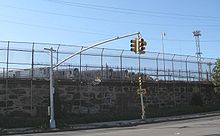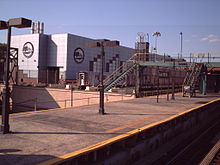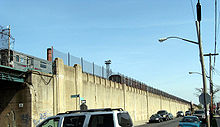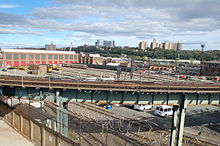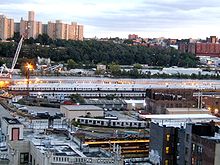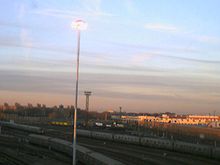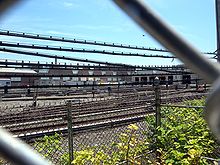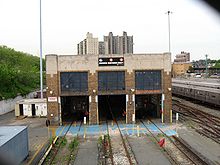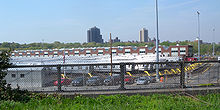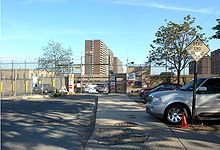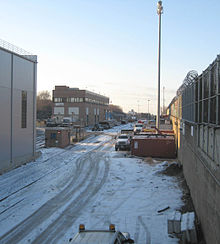- New York City Subway yards
-
The following rail yards serve the New York City Subway:
Contents
A Division Yards
137th Street Yard
The 137th Street Yard is an underground rail yard located just north of 137th Street – City College on the IRT Broadway – Seventh Avenue Line, hence the yard's name. It is composed of five tracks surrounding the three mainline tracks. Three tracks are to the west of the line (downtown side) and two are to the east (uptown side). The yard is used to store trains for the 1 service.
239th Street Yard
The 239th Street Yard is the northern most rail yard located at 4570 Furman Avenue in Wakefield and is home to the R142s assigned to the 2 train. There is considerable fleet interchange with the R142s at East 180th Street Yard used for 5 service. The car wash at 239th Street is used for both services. A wheel truing machine was installed here to minimize damage caused to rail cars and track by flat wheels. The yard consists of a seven-track inspection shop and 38 layup tracks. The layup tracks are arranged on two levels and the only other yard in the system to share this trait is the East New York Yard. Access to the 239th Street Yard is located between Wakefield – 241st Street and Nereid Avenue on the IRT White Plains Road Line.
240th Street Yard
The 240th Street Yard, also known as Van Cortlandt or VC Yard, is located at 5911 Broadway in the Bronx, serving the IRT Broadway – Seventh Avenue Line. The yard consists of six inspection tracks in the shop and 15 additional layup tracks. The yard is presently home to the R62As assigned to the 1 train. The shop was built in 1906 to support the original IRT subway. The yard and shops are entirely on an elevated structure.
Corona Yard
Corona Yard serves the IRT Flushing Line (7 <7> trains). It is located in Flushing Meadows-Corona Park near Citi Field, the National Tennis Center, and the site of the 1939 and 1964 World's Fairs.
Corona Yard opened in 1928 and has seen various models of cars, including Steinway Low-Vs, BMT Qs, R12s, R14s, R15s, World's Fair R33s, World's Fair R36s in 1964, and R62As. It also contains the Casey Stengel Bus Depot.
On August 16, 2006, the original 1928 shop building was demolished, and was replaced by a new, modern shop.
East 180th Street Yard
The East 180th Street Yard, and Maintenance/Repair Shop; viewed from East 180th Street station.
The East 180th Street Yard is situated at 1145 East 180th Street in the Bronx, just east of the Bronx Zoo. The yard consists of eight storage tracks and an adjacent 12-track shop building with a connection to the nearby 19-track Unionport Yard. The yard is presently home to the R142s for the 5 train. There is also some equipment interchanged with the 2 train.
Jerome Avenue Yard
The Jerome Yard, also known as Mosholu Yard, is located at 3191 Jerome Avenue in the Bronx. This yard is home to all cars assigned to the 4 train. It is one of the three yards in the system to be under a housing complex (Pitkin Yard and Lenox Yard are the others).
Lenox Yard
Lenox Yard is located near 148th Street in Harlem, New York. It has no maintenance facility and is only used as storage of trains that operate on the 3 service. It was the first overhaul shop for the IRT and opened with the subway in 1904. Two tracks were taken from the yard in 1968 for Harlem – 148th Street station, which is the northern terminal for the 3 train.
Livonia Yard
The Livonia Yard is in East New York, Brooklyn on an entirely elevated structure at the east end of the IRT New Lots Line. One of the smaller yards in the system, it is home to the R62s on the 3 train and the ten R62As used for the 42nd Street Shuttle.
The yard consists of four inspection tracks in the shop and thirteen layup tracks. Many 3 trains are stored in the Lenox Yard in Upper Manhattan, as Livonia is not very large, and a notable amount of space within Livonia is used for the storage of 2, 4 and 5 trains.
Unionport Yard
Unionport Yard is associated with the nearby East 180th Street Yard, used primarily as a lay-up facility for the 2 and 5 trains. There are no shop or wash facilities at this yard, which was expanded in the 1990s from five tracks to its present 19. All but one track ends in bumper block. The newly-expanded yard was fully operational in 1997. The yard connects to the IRT White Plains Road Line to the south and the IRT Dyre Avenue Line to the north.
Westchester Yard
The Westchester Yard, also known as the Pelham Yard, is located in the Bronx. It has 45 layup tracks and is home to the 6 <6> trains as well as Maintenance of Way diesel trains for both the A Division and B Division. It is connected to the IRT Pelham Line in both directions between Westchester Square – East Tremont Avenue and Middletown Road stations.
There is a four-track inspection shed for electric trains and a two-track diesel repair shop. Pelham Yard also has a car wash used by the entire A Division.
B Division Yards
174th Street Yard
The 174th Street Yard is an underground rail yard on the IND Eighth Avenue Line, used to store trains for the C service. It composed of five tracks to the east of the two mainline tracks. The yard is located six blocks north of 168th Street and adjacent to 175th Street. The inner tracks at 168th Street lead towards the yard and are used by terminating C trains. This yard can hold only three full-length trains despite having five tracks.
207th Street Yard
The 207th Street Yard is located in upper Manhattan on the Harlem River north of the University Heights Bridge. It serves as the home yard for the R32s assigned to the C train.
The 207th Street Shop is one of two heavy overhaul shops in the New York City Subway system (the other being the Coney Island Yard in Brooklyn) and provides overhaul and rebuilding of most A Division cars as well as some B Division rolling stock.
The yard also stores cars that are being retired or awaiting scrapping and restores cars designated for the New York Transit Museum.
South of the yard, connecting tracks lead to the IND Eighth Avenue Line. A separate connecting track and flyover leads to the IRT Broadway – Seventh Avenue Line. 40°52′0″N 73°55′0″W / 40.866667°N 73.916667°W
Canarsie Yard
The Canarsie Yard (also known as AY Yard from its telegraphy letters) is located on the south end of the BMT Canarsie Line adjacent to Canarsie – Rockaway Parkway. It is the primary layup yard for the L train and hosts the only car wash for the entire BMT Eastern Division, washing trains for the J, L, M and Z services. Signals were installed in 2003 in conjunction with the BMT Canarsie Line automation project. This greatly increases the safety of train movements in the yard, as the L train has some of the fastest growing ridership in the system.
Church Avenue Yard
The Church Avenue Yard is an underground rail yard on the IND Culver Line, used to store trains for the G service. It is composed of four tracks directly under the four main line tracks above. There are two ramps between each local and express track south of Church Avenue station for access. Each track can hold one full-length train between the bumper blocks and the crossovers.
Coney Island Complex
The Coney Island Complex is the largest rapid transit yard in the world. Located in Brooklyn, New York, it covers 75 acres (300,000 m2) and operates 24/7.
The complex was built in 1926 on former marshlands that, along with Coney Island Creek, formerly separated Coney Island from the main body of Brooklyn. Much of this land had originally been proposed for use as a ship canal and port facility.
Regular scheduled maintenance is performed here for a fleet of nearly 800 cars serving the B, D, G, N, Q and Franklin Avenue Shuttle trains. The shop facility along with 207th St. does heavy maintenance and overhaul for every one of the approximately 6,000 cars in the subway system, including the Staten Island Railway.
In addition to heavy maintenance facilities and track facilities for cars undergoing maintenance and overhaul, the complex includes three related railroad storage yards. The main yard facility, known as "Coney Island Yard," includes direct connections to the adjacent BMT Sea Beach Line (N train) and a two-track elevated structure to the BMT West End Line (D train). The main yard also serves trains on the BMT Brighton Line (B Q trains) via tracks C & D (aka 3 & 4) of Coney Island – Stillwell Avenue station. The adjacent but separate Culver (or "City") Yard connects to the IND Culver Line (F train) at the eastern border of the yard complex. Another yard, "Stillwell Yard," used mainly for off-peak train storage, is located across the Sea Beach Line from the main yard complex in a "V" between the divergent Sea Beach and West End Lines.
In addition to the maintenance shop and yards, there is a Health Center (gym) for Transit Authority employees and a firing range for the New York City Police Department (NYPD). The range was originally built for the New York City Transit Police Department, which was merged with the NYPD in 1995.
The Coney Island Yard Electric Motor Repair Shop and Coney Island Yard Gatehouse were listed on the National Register of Historic Places in 2006.[1] 40°35′10″N 73°58′40″W / 40.58611°N 73.97778°W
Concourse Yard
The Concourse Yard is located in northern Bronx near 205th Street and Jerome Avenue. Most D trains are maintained at this yard, although many trains assigned to the B and 4 services are stored here as well. Connecting tracks lead north from the yard to the IND Concourse Line and south to the IRT Jerome Avenue Line. The Concourse Yard Entry Buildings and Concourse Yard Substation were listed on the National Register of Historic Places in 2006.[1]
East New York Yard
East New York Yard (also known as DO Yard from its telegraphy letters) is primarily used to store and repair trains on the J, L, M and Z trains. Subway equipment is inspected and maintained there on a regular basis.
It is located at the junction of the Canarsie and Jamaica Lines near the intersection of Broadway and Jamaica Avenue in East New York, Brooklyn. A separate part of the facility houses the East New York Bus Depot, formerly a trolley depot. The yard is entirely equipped with hand-operated switches. Only the Fresh Pond Yard and 36th–38th Street Yard share this characteristic.
Portions of the yard date back to 1885 and the Lexington Avenue Elevated and the yard predates the rebuilding of nearby Broadway Junction, which was formerly known as Manhattan Junction or East New York Loop.
The yard and its main lead configuration remained the same before and after the extensive elevated line rebuilding nearby, but additional track and structure was built, so that, at its peak, East New York Yard had direct connections to the Broadway Elevated going west, Jamaica Line going east, Canarsie Line going east, and Fulton Street Elevated both east and west.
Fresh Pond Yard
The Fresh Pond Yard in Middle Village, Queens is used for storing the R160As that run on the M train. It is located between Fresh Pond Road and Middle Village – Metropolitan Avenue on the BMT Myrtle Avenue Line, but is only accessible from the latter station. Trains must first platform there and then reverse into the yard. The yard is entirely equipped with hand-operated switches. Only East New York Yard and 36th–38th Street Yard share this characteristic.
Jamaica Yard
Jamaica Yard is located in Kew Gardens, Queens at the south end of Flushing Meadows–Corona Park. It is connected to the IND Queens Boulevard Line at a three-way flying junction. The yard is on surface level, and the four-track approach includes a bridge over the Grand Central Parkway, despite the Queens Boulevard Line being underground.[2] The site upon which the yard sits at the head of the valley of the Flushing River was, during the American Revolution, occupied by British troops after the Battle of Long Island.[3]
The yard was built for the Independent Subway System in the 1930s and served as the south end of the World's Fair Railroad in 1939 and 1940. The yard provides carwash, interior cleaning, grease and minor repair services to the R46s and R160s that are assigned to the E, F, and R trains.[4][5]
The Metropolitan Transportation Authority plans to enlarge the yard.[6]
Pitkin Yard
The Pitkin Yard is located in East New York, Brooklyn. It holds the Pitkin Shops, which maintain the R46s used on the A train and Rockaway Park Shuttle.
Track connections from the yard connect both railroad north to Euclid Avenue and railroad south past Grant Avenue on the IND Fulton Street Line. This allows trains to be added or removed from service in either direction.
Rockaway Park Yard
Rockaway Park Yard is located in Rockaway Park, Queens. It is a layup yard for the R46s on the Rockaway Park Shuttle and A train, although they are primarily maintained at the Pitkin Yard in Brooklyn. R40A #4292-93 are used for school training in this yard. This yard is adjacent to Rockaway Park – Beach 116th Street. Like the IND Rockaway Line itself, the Rockaway Yard was originally a yard for the Rockaway Beach Branch of the Long Island Rail Road. It included a water tower, a roundhouse, and an elevated loop track for Brooklyn Rapid Transit trains.
Other Yards
36th-38th Street Yard
The 36th–38th Street Yard is located between Fifth and Seventh Avenues in Sunset Park, Brooklyn, adjacent to the Jackie Gleason Bus Depot. This yard is not normally used for revenue-service train maintenance, though some trains for the R service are stored here. Its primary function is to store diesel and electrically powered maintenance-of-way and other non-revenue service rolling stock. It is also used to transfer trash from garbage collector trains to trucks via platforms inside the yard just south of 37th Street.
This southern part of the yard was formerly the center of the South Brooklyn Railway, which extended from Bush Terminal through the north part of the yard, then down Gravesend Avenue and into the Coney Island Yard. One of the primary functions of this yard today is The yard is entirely equipped with hand-operated switches. Only Fresh Pond Yard and East New York Yard share this characteristic. 40°38′52″N 73°59′48″W / 40.64778°N 73.99667°W
Linden Shops
Linden Shops is a track shop, where track switches and other components are assembled. It has track connections to the IRT New Lots Line and BMT Canarsie Line but has no third rail, restricting the facility to diesel-powered trains only. There is also a track connection to the Long Island Rail Road's Bay Ridge Branch. This connection is one of two from the subway to the mainline United States rail network (The BMT West End Line is the other).
References
- ^ a b "National Register Information System". National Register of Historic Places. National Park Service. 2009-03-13. http://nrhp.focus.nps.gov/natreg/docs/All_Data.html.
- ^ Track map created by Peter Dougherty and published in his book "Tracks of the New York City Subway" (Fourth Edition)
- ^ Richmond Hill Record
- ^ UTU Article 2004
- ^ Kennedy, Randy (October 27, 2004). "A Day in the Subway, as It Rolls Up a Century". New York Times. http://www.nytimes.com/2004/10/27/nyregion/27subway.html. Retrieved September 2, 2009.
- ^ MTA, Capital Program 2005–2009, accessed April 17, 2007
External links
New York City Subway Services 


Unused
or defunct8 · 9 · AA · BB · CC · EE (8 Avenue) · EE (Broadway) · GG · H · HH (Court Street) · HH (Rockaway Park) · JJ · K (Jamaica) · K (8 Avenue) · KK · LL · MJ · NX · P · QB · QJ · QT · RJ · RR · T · TT · U · V · W · X · Y · JFK Express
ShuttlesBMTCapital projects Divisions A Division (IRT) · B Division (BMT · IND)Stations BoroughsThe Bronx · Brooklyn · Manhattan · QueensTypesOther lists Miscellaneous Staten Island Railway · Automation · Chaining · History · Fares · MetroCard · Nomenclature · Rolling stock · Proposed expansion (1929–1940)Categories:- New York City Subway yards and shops
Wikimedia Foundation. 2010.


